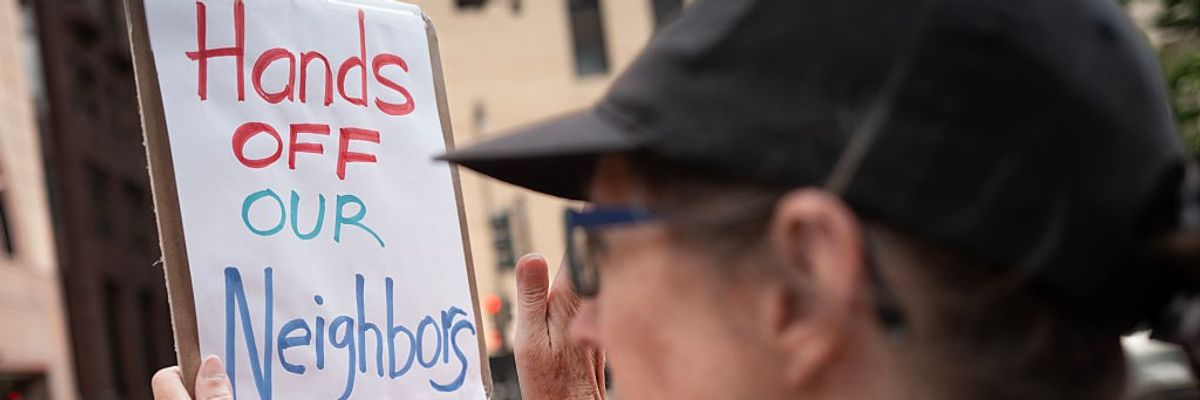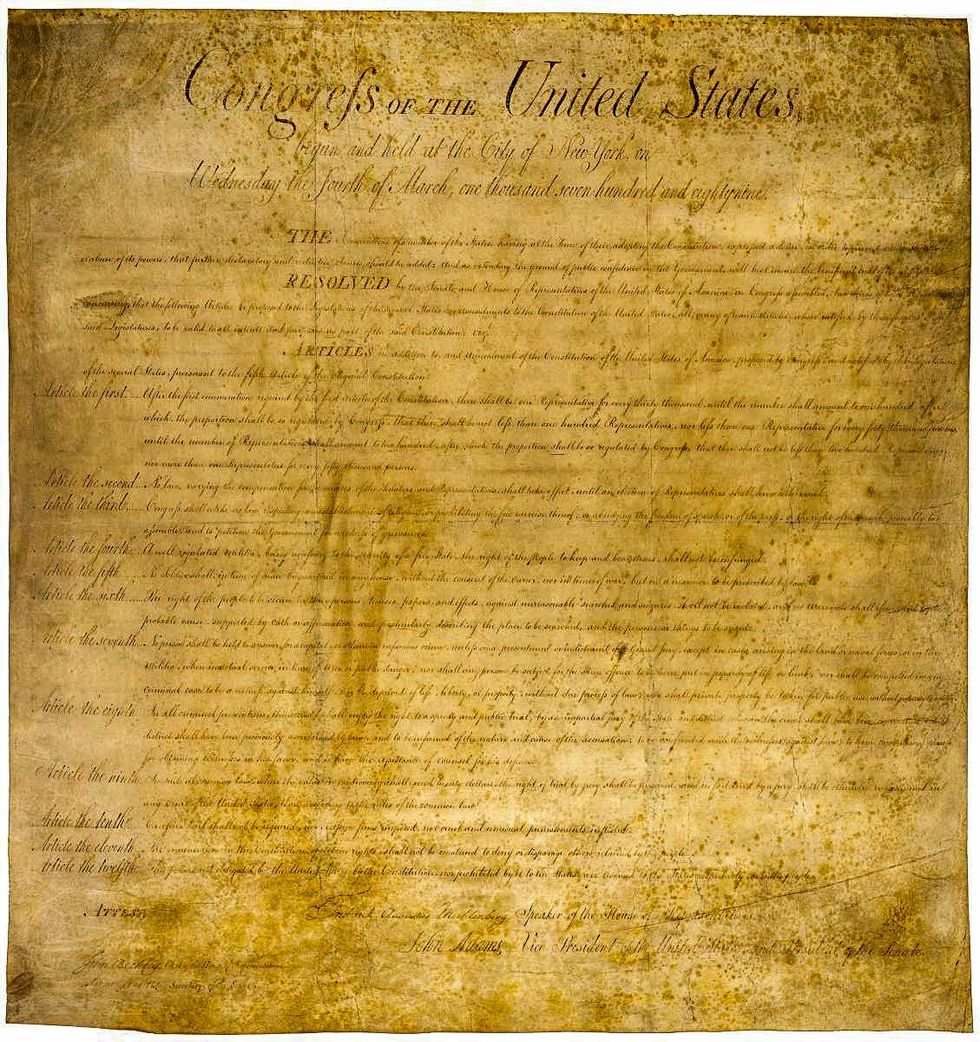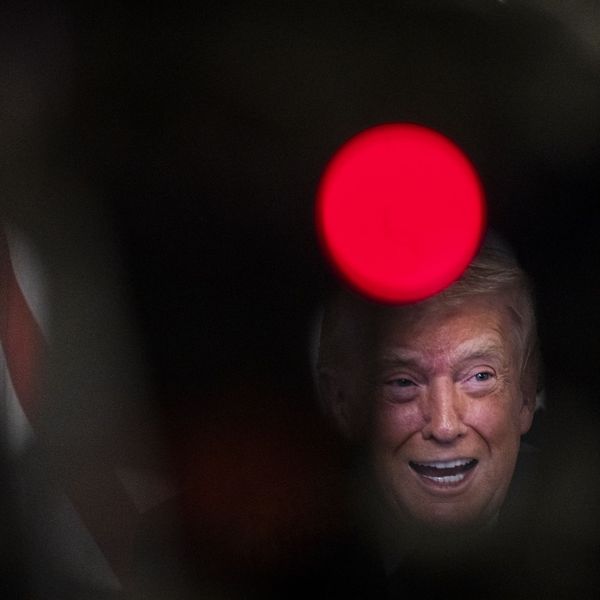
Demonstrators protest outside of a US Immigration and Customs Enforcement field office on July 28, 2025 in Chicago, Illinois.
To the Fourth Amendment: You Were Great While We Knew You
Trump is aping King George III in attacking constitutional restraints on unreasonable searches and seizures.
Suppose the police want to get illegal drugs off the streets, and they believe Black and brown people most likely to be carrying and selling drugs.
One way the cops could go about suppressing drugs would be stopping most of the Black and brown people on the streets (at gunpoint, since drug dealers might be armed); lean them up against a wall; frisk them; and search their pockets, wallets, and hand bags. They could also force their way into every house on the street to search for drugs.
The great majority of people frightened, humiliated, and invaded wouldn’t be criminals. But the police would likely seize some drugs and arrest some dealers.
Can they do that?
The United States Constitution affords a clear answer: No.
The assault in Chicago was what the Framers of our Constitution feared and what they hoped our Bill of Rights could thwart. But a Constitution is not self defending.
The Fourth Amendment to the Constitution provides, “The right of the people to be secure in their persons, houses, papers, and effects, against unreasonable searches and seizures, shall not be violated...”
And further: “No Warrants shall issue, but upon probable cause, supported by Oath or affirmation, and particularly describing the place to be searched, and the persons or things to be seized.”
The Fourth Amendment Was the Founding Fathers Response to Invasive Royal Officers

This means you’ve got a right to be left alone unless the police present evidence showing that there’s a strong chance you’ve committed a crime, and a judge issues a warrant.
How’s the Fourth Amendment doing these days?
Not too well. For years, right-wingers attacked these rights as “technicalities” for freeing criminals when the cops ignored the Fourth. But those who wrote our Constitution knew alleged crime could be an excuse for abuses, and they valued security from searches and seizures highly. Indeed, the King of England’s defilement of such rights was “one of the driving forces behind the American Revolution itself,” the Supreme Court has explained.
“The Fourth Amendment was the founding generation’s response” to supposed law enforcement “which allowed British officers to rummage through homes in an unrestrained search for evidence of criminal activity."
The abuses that provoked the American Revolution are no longer ancient history. In the name of fighting “chaos” and an imaginary crime wave, President Donald Trump has launched a broad assault on the Fourth Amendment as part of substituting a Trump-loyal, federal, militarized force for local civilian control of law enforcement.
Trump has openly proclaimed his militaristic intentions, threatening, “Chicago about to find out why it’s called the Department of WAR.” Immigration and Customs Enforcement (ICE) commandos conducted a military assault on a five-story apartment building in Chicago. There was no attempt to persuade a judge that anyone—let alone everyone in the building—was likely a criminal, and no judge issued any warrants.
Trump’s Lies and His War Against the American People and Our Constitution
ICE agents dropped from Black Hawk helicopters onto the roof of the building. Then, as reported by Time magazine, “agents worked their way through the building, kicking down doors and throwing flash bang grenades, rounding up adults and screaming children alike, detaining them in zip-ties.”
The ICE agents seized everyone in the building. They pointed guns in the faces of citizens, handcuffed them and held them for hours. “Photos of the aftermath,” reported Time, “show toys and shoes littering the apartment hallways that were left in the chaos as people were pulled from their beds.”
Trump’s excuses for militarization are falsehoods. For example, a Trump-appointed federal judge recently held that Trump’s claim that Portland, Oregon, was “war ravaged” was “simply untethered to the facts.”
In his September 30 speech to 800 generals and admirals, Trump asserted, “America is under invasion from within” and signaled his intent to “use some of these dangerous cities as training grounds for our military.” The Chicago apartment building action occurred the same day, and may be a model of the “training” Trump favors.
When Donald Trump Apes George III—and We Must Respond Accordingly: No Kings!

In recent months a series of national demonstrations have embodied the theme, “No Kings!” Aptly so.
One of the complaints listed against King George III in the Declaration of Independence, and a reason for separating from England, was: “He has affected to render the Military independent of and superior to the Civil power.”
The assault in Chicago was what the Framers of our Constitution feared and what they hoped our Bill of Rights could thwart. But a Constitution is not self defending.
As Trump muses over an unconstitutional third term (“A lot of people want me to do it”), uses the summary execution of alleged drug smugglers as a model of military power, and invokes pretend uprisings to justify federalizing the National Guard, the danger is real and imminent. But we defeated a King in 1783 and—if we all recognize the danger and are prepared to stand up for our democracy—we can do it again.
An Urgent Message From Our Co-Founder
Dear Common Dreams reader, The U.S. is on a fast track to authoritarianism like nothing I've ever seen. Meanwhile, corporate news outlets are utterly capitulating to Trump, twisting their coverage to avoid drawing his ire while lining up to stuff cash in his pockets. That's why I believe that Common Dreams is doing the best and most consequential reporting that we've ever done. Our small but mighty team is a progressive reporting powerhouse, covering the news every day that the corporate media never will. Our mission has always been simple: To inform. To inspire. And to ignite change for the common good. Now here's the key piece that I want all our readers to understand: None of this would be possible without your financial support. That's not just some fundraising cliche. It's the absolute and literal truth. We don't accept corporate advertising and never will. We don't have a paywall because we don't think people should be blocked from critical news based on their ability to pay. Everything we do is funded by the donations of readers like you. Will you donate now to help power the nonprofit, independent reporting of Common Dreams? Thank you for being a vital member of our community. Together, we can keep independent journalism alive when it’s needed most. - Craig Brown, Co-founder |
Suppose the police want to get illegal drugs off the streets, and they believe Black and brown people most likely to be carrying and selling drugs.
One way the cops could go about suppressing drugs would be stopping most of the Black and brown people on the streets (at gunpoint, since drug dealers might be armed); lean them up against a wall; frisk them; and search their pockets, wallets, and hand bags. They could also force their way into every house on the street to search for drugs.
The great majority of people frightened, humiliated, and invaded wouldn’t be criminals. But the police would likely seize some drugs and arrest some dealers.
Can they do that?
The United States Constitution affords a clear answer: No.
The assault in Chicago was what the Framers of our Constitution feared and what they hoped our Bill of Rights could thwart. But a Constitution is not self defending.
The Fourth Amendment to the Constitution provides, “The right of the people to be secure in their persons, houses, papers, and effects, against unreasonable searches and seizures, shall not be violated...”
And further: “No Warrants shall issue, but upon probable cause, supported by Oath or affirmation, and particularly describing the place to be searched, and the persons or things to be seized.”
The Fourth Amendment Was the Founding Fathers Response to Invasive Royal Officers

This means you’ve got a right to be left alone unless the police present evidence showing that there’s a strong chance you’ve committed a crime, and a judge issues a warrant.
How’s the Fourth Amendment doing these days?
Not too well. For years, right-wingers attacked these rights as “technicalities” for freeing criminals when the cops ignored the Fourth. But those who wrote our Constitution knew alleged crime could be an excuse for abuses, and they valued security from searches and seizures highly. Indeed, the King of England’s defilement of such rights was “one of the driving forces behind the American Revolution itself,” the Supreme Court has explained.
“The Fourth Amendment was the founding generation’s response” to supposed law enforcement “which allowed British officers to rummage through homes in an unrestrained search for evidence of criminal activity."
The abuses that provoked the American Revolution are no longer ancient history. In the name of fighting “chaos” and an imaginary crime wave, President Donald Trump has launched a broad assault on the Fourth Amendment as part of substituting a Trump-loyal, federal, militarized force for local civilian control of law enforcement.
Trump has openly proclaimed his militaristic intentions, threatening, “Chicago about to find out why it’s called the Department of WAR.” Immigration and Customs Enforcement (ICE) commandos conducted a military assault on a five-story apartment building in Chicago. There was no attempt to persuade a judge that anyone—let alone everyone in the building—was likely a criminal, and no judge issued any warrants.
Trump’s Lies and His War Against the American People and Our Constitution
ICE agents dropped from Black Hawk helicopters onto the roof of the building. Then, as reported by Time magazine, “agents worked their way through the building, kicking down doors and throwing flash bang grenades, rounding up adults and screaming children alike, detaining them in zip-ties.”
The ICE agents seized everyone in the building. They pointed guns in the faces of citizens, handcuffed them and held them for hours. “Photos of the aftermath,” reported Time, “show toys and shoes littering the apartment hallways that were left in the chaos as people were pulled from their beds.”
Trump’s excuses for militarization are falsehoods. For example, a Trump-appointed federal judge recently held that Trump’s claim that Portland, Oregon, was “war ravaged” was “simply untethered to the facts.”
In his September 30 speech to 800 generals and admirals, Trump asserted, “America is under invasion from within” and signaled his intent to “use some of these dangerous cities as training grounds for our military.” The Chicago apartment building action occurred the same day, and may be a model of the “training” Trump favors.
When Donald Trump Apes George III—and We Must Respond Accordingly: No Kings!

In recent months a series of national demonstrations have embodied the theme, “No Kings!” Aptly so.
One of the complaints listed against King George III in the Declaration of Independence, and a reason for separating from England, was: “He has affected to render the Military independent of and superior to the Civil power.”
The assault in Chicago was what the Framers of our Constitution feared and what they hoped our Bill of Rights could thwart. But a Constitution is not self defending.
As Trump muses over an unconstitutional third term (“A lot of people want me to do it”), uses the summary execution of alleged drug smugglers as a model of military power, and invokes pretend uprisings to justify federalizing the National Guard, the danger is real and imminent. But we defeated a King in 1783 and—if we all recognize the danger and are prepared to stand up for our democracy—we can do it again.
Suppose the police want to get illegal drugs off the streets, and they believe Black and brown people most likely to be carrying and selling drugs.
One way the cops could go about suppressing drugs would be stopping most of the Black and brown people on the streets (at gunpoint, since drug dealers might be armed); lean them up against a wall; frisk them; and search their pockets, wallets, and hand bags. They could also force their way into every house on the street to search for drugs.
The great majority of people frightened, humiliated, and invaded wouldn’t be criminals. But the police would likely seize some drugs and arrest some dealers.
Can they do that?
The United States Constitution affords a clear answer: No.
The assault in Chicago was what the Framers of our Constitution feared and what they hoped our Bill of Rights could thwart. But a Constitution is not self defending.
The Fourth Amendment to the Constitution provides, “The right of the people to be secure in their persons, houses, papers, and effects, against unreasonable searches and seizures, shall not be violated...”
And further: “No Warrants shall issue, but upon probable cause, supported by Oath or affirmation, and particularly describing the place to be searched, and the persons or things to be seized.”
The Fourth Amendment Was the Founding Fathers Response to Invasive Royal Officers

This means you’ve got a right to be left alone unless the police present evidence showing that there’s a strong chance you’ve committed a crime, and a judge issues a warrant.
How’s the Fourth Amendment doing these days?
Not too well. For years, right-wingers attacked these rights as “technicalities” for freeing criminals when the cops ignored the Fourth. But those who wrote our Constitution knew alleged crime could be an excuse for abuses, and they valued security from searches and seizures highly. Indeed, the King of England’s defilement of such rights was “one of the driving forces behind the American Revolution itself,” the Supreme Court has explained.
“The Fourth Amendment was the founding generation’s response” to supposed law enforcement “which allowed British officers to rummage through homes in an unrestrained search for evidence of criminal activity."
The abuses that provoked the American Revolution are no longer ancient history. In the name of fighting “chaos” and an imaginary crime wave, President Donald Trump has launched a broad assault on the Fourth Amendment as part of substituting a Trump-loyal, federal, militarized force for local civilian control of law enforcement.
Trump has openly proclaimed his militaristic intentions, threatening, “Chicago about to find out why it’s called the Department of WAR.” Immigration and Customs Enforcement (ICE) commandos conducted a military assault on a five-story apartment building in Chicago. There was no attempt to persuade a judge that anyone—let alone everyone in the building—was likely a criminal, and no judge issued any warrants.
Trump’s Lies and His War Against the American People and Our Constitution
ICE agents dropped from Black Hawk helicopters onto the roof of the building. Then, as reported by Time magazine, “agents worked their way through the building, kicking down doors and throwing flash bang grenades, rounding up adults and screaming children alike, detaining them in zip-ties.”
The ICE agents seized everyone in the building. They pointed guns in the faces of citizens, handcuffed them and held them for hours. “Photos of the aftermath,” reported Time, “show toys and shoes littering the apartment hallways that were left in the chaos as people were pulled from their beds.”
Trump’s excuses for militarization are falsehoods. For example, a Trump-appointed federal judge recently held that Trump’s claim that Portland, Oregon, was “war ravaged” was “simply untethered to the facts.”
In his September 30 speech to 800 generals and admirals, Trump asserted, “America is under invasion from within” and signaled his intent to “use some of these dangerous cities as training grounds for our military.” The Chicago apartment building action occurred the same day, and may be a model of the “training” Trump favors.
When Donald Trump Apes George III—and We Must Respond Accordingly: No Kings!

In recent months a series of national demonstrations have embodied the theme, “No Kings!” Aptly so.
One of the complaints listed against King George III in the Declaration of Independence, and a reason for separating from England, was: “He has affected to render the Military independent of and superior to the Civil power.”
The assault in Chicago was what the Framers of our Constitution feared and what they hoped our Bill of Rights could thwart. But a Constitution is not self defending.
As Trump muses over an unconstitutional third term (“A lot of people want me to do it”), uses the summary execution of alleged drug smugglers as a model of military power, and invokes pretend uprisings to justify federalizing the National Guard, the danger is real and imminent. But we defeated a King in 1783 and—if we all recognize the danger and are prepared to stand up for our democracy—we can do it again.

